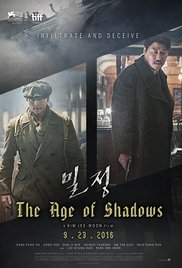
THE AGE OF SHADOWS
Korea, 2016, 140 minutes, Colour.
Byung hun Lee, You Gong, Kang-ho Song.
Directed by Kim Jee-woon.
In recent years the Korean film industry has produced a number of films about the 1920s and the 1930s, The Last Princess, Handmaiden. It is the era of Japan’s colonial occupation of the Korean Peninsula and a spirit of Korean revolt.
Intending audiences would find it helpful to do a bit of research about this period, the arrogance of the Japanese domination, the spirited feeling of the Koreans, the role of the Chinese, especially during the 1930s.
This is a film with touches of espionage, opening with an attack on an art dealer and the arrival of troops, killings, arrests, torture and an introduction to what might be called the Korean Underground of resistance.
At the core of the plot is a plan to ship arms by train from Shanghai to Seoul, a group of fighters, men and women, involved – with the discovery that one is a traitor. Much of the action is on the train, the tensions with the leader of the group and the rest of the fighters, organising a test with differing pieces of information so that whoever is betraying the group will be revealed.
There is another complication that one of the earlier members of the resistance is now a respected policeman, working with the Japanese authorities, tested again about his loyalties to his commanders and his loyalties to Korea and to his earlier comrades.
The film is quite long but keeps the attention, the search for the betrayer, the role of the policeman, even to his being tested by his willingness to torture some former colleagues, and the buildup to assassination attempts.
The film recreates the period in costumes and decor, has quite an eclectic musical score which creates many different atmospheres, from classical music to electronic music – and the use of Ravel’s Bolero for a climax to the action.
The central actor, Byung-hung Lee was one of the recent Magnificent Seven.
Certainly of great interest for a Korean audience, those familiar with Korean history – but also for those who want to know about the history of Japan, Korea and China in the early part of the 20th century.
1. The title, the period in Korean history? The 1920s and 30s? Korea and is loss of independence? The Japanese domination and colonial control? Action in Shanghai, the role of China?
2. The recreation of the period, the cities, the countryside, the train and its journey? Costumes, decor?
3. The musical score? The intensity of the background electronic music, notes, cords, atmosphere? The use of a range of songs, from popular American to local? And the effective use of Ravel’s Bolero during the shooting?
4. Audience knowledge of this period, the role of the Japanese, the impact on Korea, the desire for independence, foreign rule and revolt? Revolutionary movements? Oppression and suppression, the use of cruelty? The issue of Korean identity?
5. A film about espionage, resistance – and echoes of so many western films dealing with war and resistance? The dark tone, the title and the dark shadows in the cover photography?
6. A film about patriotism, moral dilemmas, loyalty?
7. The initial setup, the agent, the discussions with the dealer, the statue, the importance of time, the authorities gathering, the police? The attack, deaths, escapes and pursuits? The morale of the revolutionaries? The irony of seeing the dealer again at the end, his betrayal, his death as an execution?
8. The role of the policeman, his being part of the resistance, his now belonging to the police with loyalty to the Japanese, his moral dilemmas? His relationship with the leader of the resistance? Giving him information? The transporting of the explosives from Shanghai to Seoul? His relationship with Higashi and with the agent, Hashimoto? Hashimoto, sinister, committed, the search, his death? The policeman covering himself? Yet the dangers? The final confrontation? His deceit of the Japanese? At the reception, everybody present – and the explosion? His role in torture, the young woman and his having to exercise the torture? The leader and his arrest, imprisonment, interrogation – and the policeman and his ultimate loyalties and survival?
9. The leader of the resistance, his cover, art? His relationship with the woman, her role in the revolution? The range of his connections, allies? The team, the discussions about the mission, plans? The authorities getting information? Traitors?
10. The plan, the explosives, the cases, transporting them, evading detection, the disguises? On the train? Hashimoto and the search? The policeman and his helping, information, deflecting information to the authorities? The decision on the train, each member of the team being given a different arrival time and place? The discovery who the traitor was, closeness to the leader, his explanations of motivation, his being shot?
11. The arrival of the explosives, their safekeeping, the house, the countryside? The siege of the house? The leader and his being taken prisoner? The woman and her arrest after the police and authorities were at the railway station?
12. Torture and interrogation, the cruelty, harshness, the burning of the woman’s face? The policeman and his being forced to take part in the torture?
13. The leader, his being taken, the arrest and torture?
14. The explosives, the Japanese and the authorities or gathered together, the explosion?
15. And the survival of the policeman – and the continued operation of the Koreans into World War II?